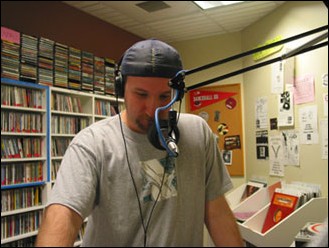What’s The Frequency?

Image: What’s The Frequency?:Junior history major Greg Flagg entertains those that can hear his show on KSSU Mondays from 2 to 4 p.m. KSSU operates from the ground floor of the University Union with three watts of power. By contrast, Capital Public Radio’s KXPR with 50,000 watts. :
November 12, 2003
Local Capital Public Radio station KXPR began as a student-runenterprise on the Sacramento State campus more than thirty yearsago.
But when it returns in a new $4.4 million building on the southend of campus in February, CPR officials say Sac State studentswill not be on staff – much less the air.
Rafael Chavez serves as the student member on the CPR board ofdirectors and program manager for Sac State’s student-runstation KSSU.
Chavez met with CPR officials Oct. 30 to discuss possibilitiesof collaboration with students.
“At this point all they had to discuss was the possibilityof internship,” Chavez said.
He said that CPR is supposed to represent the community, but thecommunity from which its license stems has littlerepresentation.
“There is a population of students interested inbroadcasting, and the university holds licenses used by CPR,”Chavez said. “Still, KSSU is the only student opportunity.Public radio and their university connection is supposed to be aneducational opportunity.”
When the new CPR building opens, Sac State will have two radiobroadcasting facilities – CPR’s set of five stations andKSSU.
There is a difference in the area that each station covers. CPRbroadcasts from Sacramento to Tahoe and Stockton to ButteCounty.
On a clear day with low sunspot activity &- consideredperfect broadcasting weather – KSSU can be heard from the residencehalls to Modoc Hall.
University director of telecommunications Spencer Freund saidthe reception of KSSU is not always predictable. Since it is anunlicensed AM frequency, the FCC does not permit broadcast strengththat could reach outside campus boundaries.
“If you want to hear KSSU, you can take an AM radio andstand outside Lassen Hall where the transmitter is located and turnthe dial to 1580,” Freund said. “Then you’ll beable to get it.”
Freund said that the possibility of a better broadcasting systemfor KSSU is unlikely and probably impossible since a license tobroadcast can cost millions of dollars.
Capital Public Radio has two Sacramento broadcast licenses -KXPR and KXJZ – and both licenses are registered in the name ofSacramento State. The licenses are connected to a seven-yearmemorandum of agreement between CPR and Sac State.
There is no stipulation in the agreement obligating CPR to covercampus agenda.
Capital Public Radio is a not-for-profit corporation and amember of National Public Radio.
Mike Lazar, the general manager for CPR, said that CPR isofficially an auxiliary of the university – a public radio stationfor Sacramento licensed through Sac State.
Lazar said that students are encouraged to apply for unpaidinternships with CPR as they open on campus, but the itinerary andnon-student staffing will not change with the move.
Capital Public Radio owes its origins to the pioneering SacState student-run station KERS.
KERS signed off the air in 1978 to make way for KXPR.
Barbara O’Connor was the chair of the CommunicationsStudies Department during the transition period to CPR, and one ofthe first members of its Board of Directors.
O’Connor said the original intention of becoming a memberof NPR was to enhance the educational opportunities in radio aswell as to obtain a license with greater broadcasting power for theuniversity.
In order to achieve public broadcasting status, a hiredprofessional staff was required and the student staff wasreplaced.
“Originally there was student involvement and our agendawas to talk about the university, student involvement, internships,shows and local news,” O’Connor said. “But allthis is real expensive and we have to serve the community by givingthe community what they want.”
When KXPR started broadcasting student and faculty involvementand campus agenda was strong.
Today, the student involvement consists of one student member onthe CPR Board of Directors.
The student broadcasting void was filled by a new student-runstation in 1989 – three years later this station became KSSU.
Senior business major Marcus Owens runs the L7 music hour onFriday afternoons on KSSU. He said that the move of CPR back oncampus and the lack of opportunities for students is an insult.
“An offer of internships is ridiculous,” Owens said.”Students here at Sac State could get a real internship atalmost any station. I went straight into a paidposition.”
Owens works as a remote technician for Sacramento stationKSFM.
Still, many Sac State faculty and administrators view the moveof CPR to campus as a starting point for opportunity for studentsinterested in broadcasting.
“Students have a tremendous drive – they have their heartin the right place,” Freund said. “If given a chance atpartnerships they would be successful, but it takes time andeffort. CPR coming to campus will be great for this – they willopen a door for students it is just a matter of time andfaith.”




































































































































